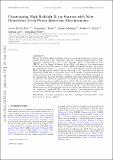Constraining high-redshift X-ray sources with next generation 21-cm power spectrum measurements
Author(s)
Mesinger, Andrei; Pober, Jonathan; Ewall-Wice, Aaron Michael; Hewitt, Jacqueline N; Dillon, Joshua Shane; Liu, Adrian Chi-Yan; ... Show more Show less
DownloadConstraining high redshift.pdf (771.3Kb)
OPEN_ACCESS_POLICY
Open Access Policy
Creative Commons Attribution-Noncommercial-Share Alike
Terms of use
Metadata
Show full item recordAbstract
We use the Fisher matrix formalism and seminumerical simulations to derive quantitative predictions of the constraints that power spectrum measurements on next-generation interferometers, such as the Hydrogen Epoch of Reionization Array (HERA) and the Square Kilometre Array (SKA), will place on the characteristics of the X-ray sources that heated the high-redshift intergalactic medium. Incorporating observations between z = 5 and 25, we find that the proposed 331 element HERA and SKA phase 1 will be capable of placing ≲ 10 per cent constraints on the spectral properties of these first X-ray sources, even if one is unable to perform measurements within the foreground contaminated ‘wedge’ or the FM band. When accounting for the enhancement in power spectrum amplitude from spin temperature fluctuations, we find that the observable signatures of reionization extend well beyond the peak in the power spectrum usually associated with it. We also find that lower redshift degeneracies between the signatures of heating and reionization physics lead to errors on reionization parameters that are significantly greater than previously predicted. Observations over the heating epoch are able to break these degeneracies and improve our constraints considerably. For these two reasons, 21-cm observations during the heating epoch significantly enhance our understanding of reionization as well.
Date issued
2016-02Department
Massachusetts Institute of Technology. Department of Physics; MIT Kavli Institute for Astrophysics and Space ResearchJournal
Monthly Notices of the Royal Astronomical Society
Publisher
Oxford University Press
Citation
Ewall-Wice, Aaron; Hewitt, Jacqueline; Mesinger, Andrei; Dillon, Joshua S.; Liu, Adrian and Pober, Jonathan. “Constraining High-Redshift X-Ray Sources with Next Generation 21-Cm Power Spectrum Measurements.” Monthly Notices of the Royal Astronomical Society 458, no. 3 (February 26, 2016): 2710–2724. © 2016 The Authors
Version: Author's final manuscript
ISSN
0035-8711
1365-2966